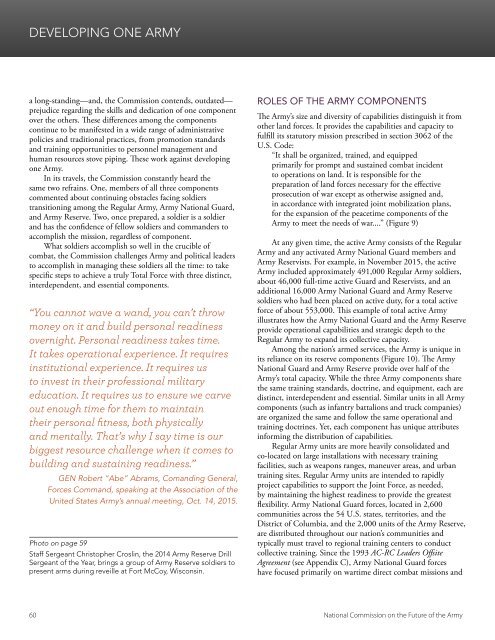THE FUTURE OF THE ARMY
Futurearmy
Futurearmy
Create successful ePaper yourself
Turn your PDF publications into a flip-book with our unique Google optimized e-Paper software.
DEVELOPING ONE <strong>ARMY</strong><br />
a long-standing—and, the Commission contends, outdated—<br />
prejudice regarding the skills and dedication of one component<br />
over the others. These differences among the components<br />
continue to be manifested in a wide range of administrative<br />
policies and traditional practices, from promotion standards<br />
and training opportunities to personnel management and<br />
human resources stove piping. These work against developing<br />
one Army.<br />
In its travels, the Commission constantly heard the<br />
same two refrains. One, members of all three components<br />
commented about continuing obstacles facing soldiers<br />
transitioning among the Regular Army, Army National Guard,<br />
and Army Reserve. Two, once prepared, a soldier is a soldier<br />
and has the confidence of fellow soldiers and commanders to<br />
accomplish the mission, regardless of component.<br />
What soldiers accomplish so well in the crucible of<br />
combat, the Commission challenges Army and political leaders<br />
to accomplish in managing these soldiers all the time: to take<br />
specific steps to achieve a truly Total Force with three distinct,<br />
interdependent, and essential components.<br />
“You cannot wave a wand, you can’t throw<br />
money on it and build personal readiness<br />
overnight. Personal readiness takes time.<br />
It takes operational experience. It requires<br />
institutional experience. It requires us<br />
to invest in their professional military<br />
education. It requires us to ensure we carve<br />
out enough time for them to maintain<br />
their personal fitness, both physically<br />
and mentally. That’s why I say time is our<br />
biggest resource challenge when it comes to<br />
building and sustaining readiness.”<br />
GEN Robert “Abe” Abrams, Comanding General,<br />
Forces Command, speaking at the Association of the<br />
United States Army’s annual meeting, Oct. 14, 2015.<br />
Photo on page 59<br />
Staff Sergeant Christopher Croslin, the 2014 Army Reserve Drill<br />
Sergeant of the Year, brings a group of Army Reserve soldiers to<br />
present arms during reveille at Fort McCoy, Wisconsin.<br />
ROLES <strong>OF</strong> <strong>THE</strong> <strong>ARMY</strong> COMPONENTS<br />
The Army’s size and diversity of capabilities distinguish it from<br />
other land forces. It provides the capabilities and capacity to<br />
fulfill its statutory mission prescribed in section 3062 of the<br />
U.S. Code:<br />
“It shall be organized, trained, and equipped<br />
primarily for prompt and sustained combat incident<br />
to operations on land. It is responsible for the<br />
preparation of land forces necessary for the effective<br />
prosecution of war except as otherwise assigned and,<br />
in accordance with integrated joint mobilization plans,<br />
for the expansion of the peacetime components of the<br />
Army to meet the needs of war....” (Figure 9)<br />
At any given time, the active Army consists of the Regular<br />
Army and any activated Army National Guard members and<br />
Army Reservists. For example, in November 2015, the active<br />
Army included approximately 491,000 Regular Army soldiers,<br />
about 46,000 full-time active Guard and Reservists, and an<br />
additional 16,000 Army National Guard and Army Reserve<br />
soldiers who had been placed on active duty, for a total active<br />
force of about 553,000. This example of total active Army<br />
illustrates how the Army National Guard and the Army Reserve<br />
provide operational capabilities and strategic depth to the<br />
Regular Army to expand its collective capacity.<br />
Among the nation’s armed services, the Army is unique in<br />
its reliance on its reserve components (Figure 10). The Army<br />
National Guard and Army Reserve provide over half of the<br />
Army’s total capacity. While the three Army components share<br />
the same training standards, doctrine, and equipment, each are<br />
distinct, interdependent and essential. Similar units in all Army<br />
components (such as infantry battalions and truck companies)<br />
are organized the same and follow the same operational and<br />
training doctrines. Yet, each component has unique attributes<br />
informing the distribution of capabilities.<br />
Regular Army units are more heavily consolidated and<br />
co-located on large installations with necessary training<br />
facilities, such as weapons ranges, maneuver areas, and urban<br />
training sites. Regular Army units are intended to rapidly<br />
project capabilities to support the Joint Force, as needed,<br />
by maintaining the highest readiness to provide the greatest<br />
flexibility. Army National Guard forces, located in 2,600<br />
communities across the 54 U.S. states, territories, and the<br />
District of Columbia, and the 2,000 units of the Army Reserve,<br />
are distributed throughout our nation’s communities and<br />
typically must travel to regional training centers to conduct<br />
collective training. Since the 1993 AC-RC Leaders Offsite<br />
Agreement (see Appendix C), Army National Guard forces<br />
have focused primarily on wartime direct combat missions and<br />
60 National Commission on the Future of the Army


